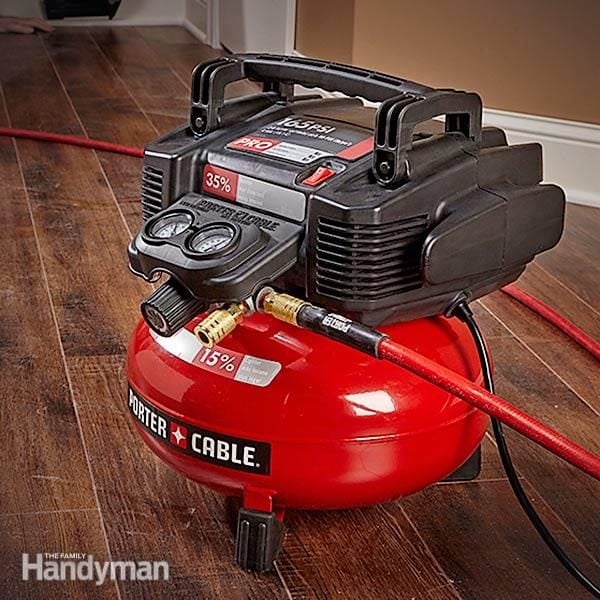When you’re shopping for a small air compressor, the first thing you’ll notice is that they’re typically plastered with specifications and technical jargon. But don’t let all those specs confuse you. Here we’ll tell you what all of those technical terms mean, which of them matter and which don’t, and help you choose a compressor to suit your needs.
Keep in mind that small air compressors are not good partners for air-hungry tools like pneumatic wrenches, sanders or paint sprayers. For those tools, you’ll need a much larger compressor.
CFM Is the Key
CFM (cubic feet per minute) tells you how fast the small air compressor can supply air. It’s usually the most important number to consider. If a tool uses air faster than the compressor can supply it, you’ll have to stop working and wait for the compressor to catch up. Every manufacturer tests its compressors at 90 psi-an average setting for a nail gun. That means you can be confident that you’re comparing apples to apples when you look at air compressor CFM numbers.
Tank Size Matters—Sometimes
Most “small” air compressors have tanks that range in size from 1-6 gallons. A larger tank holds more air and will allow you to use more air before the pressure drops and the motor kicks on to refill the tank. That might let you avoid stopping work while the compressor refills the tank. But remember this: When your work demands a lot of air volume, a large tank is no substitute for adequate CFM.
PSI Usually Isn’t a Factor
Most compressors provide more than enough pressure for DIY tools and tasks. In that sense, the pounds per square inch (psi) isn’t much of an issue or a factor in your buying decision. But a higher max psi does have one real benefit: It allows a smaller tank to hold more air and perform like a bigger tank. A 2-gallon tank at 150 psi, for example, holds as much air as a 3-gallon tank at 100 psi.
Compressors Get Loud
The decibel scale isn’t like most scales you’re used to. Going up just 10 dB doubles the level of noise. A machine rated at 70 dB, for example, is twice as loud as one rated at 60 dB. An 80-dB machine is four times as loud. So a small reduction in decibels goes a long way in making a machine more pleasant to operate.
Portability Isn’t Just About Weight
Weight isn’t the only factor in determining whether a compressor is easy to carry. Shape matters too. A slim small air compressor unit is the easiest to tote; wide ones are the most awkward. We’ve noted the best air compressor and the worst in our reviews.
Enough Power for Nailers?
If you’re looking to power a framing nailer with this compressor, it will need to be pretty powerful. Only compressors with ratings of about 2 CFM or higher will keep up with a framing nailer when you’re working at moderate speed. Those with lower CFM ratings will require patience; you’ll drive a few nails, then wait for the small compressor to catch up.
Oil-Free Is the Norm
Almost all small air compressors are now ‘oil-less,’ which means you never have to worry about checking or changing oil. An oil-less small air compressor generally wears out faster than oil-lubricated models, but that’s not likely to be an issue with normal DIY use of a small air compressor.
Ignore Horsepower
To get the best read on the amount of airpower a small air compressor can deliver, look at CFM, not horsepower.
Shrouding Prevents Damage
One of the benefits of a small compressor is that you can take it virtually anywhere. The downside is that a small air compressor is likely to get battered. The tank will be fine, but the gauges and outlets are vulnerable unless they’re protected.
Other Features to Look For in the Best Small Air Compressor
- Ball valve drain. Water that condenses in a compressor’s tank leads to rusting and pinhole leaks. To prevent this, manufacturers recommend that you drain the tank regularly. All tanks have drains, but there are two different types. The simplest is a drain cock, which is awkward to use, and you may even need pliers. We prefer a ball valve drain, which works like a faucet.
- Cord wrap. Most compressors provide a convenient way to wrap up the power cord for easy carrying.
- Two outlets. Most compressors have a single outlet for connecting an air hose, but a few have two, which lets you and a buddy work together.
- Kits and accessories. For extra value, look for compressors that come with a hose or a set of inflation accessories. Some may be bundled with a nail gun and hose under a different model number.
Article source here: How to Choose a Small Air Compressor



No comments:
Post a Comment